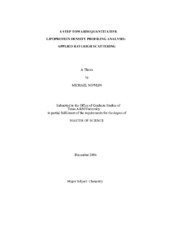| dc.description.abstract | Ultracentrifugation and imaging techniques of human blood serum are precise and information-rich methods for obtaining information about an individual’s lipoprotein particle content. The information derived from lipoprotein separations via an ultracentrifuge plays a key role in the area of preventative medicine in regards to atherosclerosis. Two of the most critical lipoprotein characteristics, diameter and density, are well preserved with the proper isopycnic gradient. Currently, lipoprotein particles are stained, ultracentrifuged, and profiled through image analysis. This particular technique is helpful in determining particle density and can be correlated loosely with particle concentration. The need to completely quantify lipoprotein concentrations is imperative in assessing risk factors accurately. Light scattering techniques, primarily Rayleigh scattering, are applied to density separated serum samples in resulting in improved qualitative data with progress in quantitative measurements through imaging alone. The Rayleigh theory dictates that a particle’s scattered intensity is based upon the incident intensity, the particle’s diameter, and the particle’s concentration when strict criteria are met within the sample and imaging apparatus. Applying this innovative imaging technique of Rayleigh scattering to ultracentrifuge tubes containing separated lipoproteins, particle concentrations at differing diameters can be calculated. This thesis primarily goes through the time consuming task of optimizing the innovative Rayleigh scattering system so that correct quantitative estimations can be performed. Constrained by Rayleigh theory and system limitations, lipoproteins of 15 nm to 35 nm are focused upon. By doing so, previously disguised data in regards to lipoprotein subclasses is exposed. Lipoprotein diameters are estimated from Rayleigh imaged serum profiles and the estimations are confirmed through secondary size analysis achieved by dynamic light scattering instrumentation. In addition to Rayleigh optimization, a strategy for quantifying the ultracentrifuged lipoprotein particles using the recently applied scattering technique is explained in detail providing a foundation for further research. In regards to all feasibility studies presented within this thesis, much success was achieved in furthering quantitation efforts in lipoprotein density profiling. | en |


